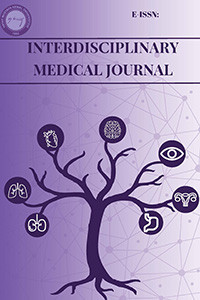UYKU APNE SENDROMU OLAN HASTALARDA KARDİYOVASKÜLER HASTALIĞIN BİR GÖSTERGESİ OLAN AORTİK SERTLİĞİN EKOKARDİYOGRAFİ İLE DEĞERLENDİRİLMESİ
Uyku apne sendromu, aort sertliği, kardiyovasküler hastalık
Assesment of Aortic Stiffness as an Indicator of Cardiovascular Disease in Patients with Obstructive Sleep Apnea by using Echocardiography
___
- Marin JM, Carrizo SJ, Vicente E, Agusti AG. Long-term cardiovascular outcomes in
- men with obstructive sleep apnoea-hypopnoea with or without treatment with
- continuous positive airway pressure: an observational study. Lancet. 2005 Mar 19-
- ;365(9464):1046-53.
- Shahar E, Whitney CW, Redline S, Lee ET, Newman AB, Nieto FJ, et al. Sleepdisordered
- breathing and cardiovascular disease: cross-sectional results of the Sleep
- Heart Health Study. Am J Respir Crit Care Med. 2001 Jan;163(1):19-25.
- Peker Y, Hedner J, Norum J, Kraiczi H, Carlson J. Increased incidence of
- cardiovascular disease in middle-aged men with obstructive sleep apnea: a 7-year
- follow-up. Am J Respir Crit Care Med. 2002 Jul 15;166(2):159-65.
- Peker Y, Carlson J, Hedner J. Increased incidence of coronary artery disease in sleep
- apnoea: a long-term follow-up. Eur Respir J. 2006 Sep;28(3):596-602.
- Arzt M, Young T, Finn L, Skatrud JB, Bradley TD. Association of sleep-disordered
- breathing and the occurrence of stroke. Am J Respir Crit Care Med. 2005 Dec
- ;172(11):1447-51.
- Ip MS, Tse HF, Lam B, Tsang KW, Lam WK. Endothelial function in obstructive
- sleep apnea and response to treatment. Am J Respir Crit Care Med. 2004 Feb
- ;169(3):348-53.
- Pepperell JC, Ramdassingh-Dow S, Crosthwaite N, Mullins R, Jenkinson C, Stradling
- JR, et al. Ambulatory blood pressure after therapeutic and subtherapeutic nasal
- continuous positive airway pressure for obstructive sleep apnoea: a randomised
- parallel trial. Lancet. 2002 Jan 19;359(9302):204-10.
- Kohler M, Pepperell JC, Casadei B, Craig S, Crosthwaite N, Stradling JR, et al. CPAP
- and measures of cardiovascular risk in males with OSAS. Eur Respir J. 2008
- Dec;32(6):1488-96.
- Cruickshank JK, Rezailashkajani M, Goudot G. Arterial stiffness, fatness, and
- physical fitness: ready for intervention in childhood and across the life course?
- Hypertension. 2009 Apr;53(4):602-4.
- Wada T, Kodaira K, Fujishiro K, Maie K, Tsukiyama E, Fukumoto T, et al.
- Correlation of ultrasound-measured common carotid artery stiffness with pathological
- findings. Arterioscler Thromb. 1994 Mar;14(3):479-82.
- Phillips CL, Butlin M, Wong KK, Avolio AP. Is obstructive sleep apnoea causally
- related to arterial stiffness? A critical review of the experimental evidence. Sleep Med
- Rev. 2013 Feb;17(1):7-18.
- Lacombe F, Dart A, Dewar E, Jennings G, Cameron J, Laufer E. Arterial elastic
- properties in man: a comparison of echo-Doppler indices of aortic stiffness. Eur Heart
- J. 1992 Aug;13(8):1040-5.
- Executive Summary of The Third Report of The National Cholesterol Education
- Program (NCEP) Expert Panel on Detection, Evaluation, And Treatment of High
- Blood Cholesterol In Adults (Adult Treatment Panel III). JAMA. 2001 May
- ;285(19):2486-97.
- Heart rate variability. Standards of measurement, physiological interpretation, and
- clinical use. Task Force of the European Society of Cardiology and the North
- American Society of Pacing and Electrophysiology. Eur Heart J. 1996 Mar;17(3):354-
- -
- Laurent S, Boutouyrie P, Asmar R, Gautier I, Laloux B, Guize L, et al. Aortic stiffness
- is an independent predictor of all-cause and cardiovascular mortality in hypertensive
- patients. Hypertension. 2001 May;37(5):1236-41.
- Vlachopoulos C, Aznaouridis K, Stefanadis C. Prediction of cardiovascular events and
- all-cause mortality with arterial stiffness: a systematic review and meta-analysis. J Am
- Coll Cardiol. 2010 Mar 30;55(13):1318-27.
- Mitchell GF, Hwang SJ, Vasan RS, Larson MG, Pencina MJ, Hamburg NM, et al.
- Arterial stiffness and cardiovascular events: the Framingham Heart Study. Circulation.
- Feb 2;121(4):505-11.
- Ross R. Atherosclerosis--an inflammatory disease. N Engl J Med. 1999 Jan
- ;340(2):115-26.
- Shimokawa H. Primary endothelial dysfunction: atherosclerosis. J Mol Cell Cardiol.
- Jan;31(1):23-37.
- Celermajer DS, Sorensen KE, Gooch VM, Spiegelhalter DJ, Miller OI, Sullivan ID, et
- al. Non-invasive detection of endothelial dysfunction in children and adults at risk of
- atherosclerosis. Lancet. 1992 Nov 7;340(8828):1111-5.
- Schachinger V, Britten MB, Zeiher AM. Prognostic impact of coronary vasodilator
- dysfunction on adverse long-term outcome of coronary heart disease. Circulation.
- Apr 25;101(16):1899-906.
- Yayın Aralığı: Yılda 3 Sayı
- Başlangıç: 2023
- Yayıncı: Hatay Mustafa Kemal Üniversitesi Tıp Fakültesi Dekanlığı
ALOPESİ AREATADA TOPİKAL PSORALEN VE ULTRAVİOLE A FOTOKEMOTERAPİSİNİN ETKİNLİĞİNİN DEĞERLENDİRİLMESİ
Bilge Şen, Özlem Ekiz, Emine Rifaioğlu, Tuğba Şen, Asena Doğramacı
BÜYÜK SAFEN VEN YETMEZLİĞİNDE ENDOVENÖZ LAZER ABLASYON TEDAVİSİ TECRÜBELERİMİZ
Özgür Bulut, Ümit Halıcı, Atilla Kanca, Soner Sanioğlu
Savaş Sarıkaya, Şafak Şahin, Lütfi Akyol, Turan Aktaş, Yavuz İntepe, Elif Börekçi, Yunus Yılmaz
GENDEN TEDAVİYE YENİ YAKLAŞIMLAR: KODLAMAYAN NÜKLEİK ASİTLER
Hasret ECEVİT, Sedat MOTOR, Müzeyyen İZMİRLİ
Pınar Özuğuz, Seval Kaçar, Serap Polat, Sena Ulu, Şemsettin Karaca
DÜŞME HİKAYESİ BULUNAN BİR ATEŞLİ SİLAH YARALANMA OLGUSU; OLAY YERİ İNCELEMENİN ÖNEMİ
Hüseyin KAFADAR, Safiye KAFADAR
BİRİNCİ TRİMESTERDE SAPTANAN İKİ AKRANİ OLGUSU
Nesrin ATCI, Ayşe GÜLER, Hakan YERAL, Atilla KARATEKE, Hanifi BAYAROĞLU
ANESTEZİDE MERKEZİ VENÖZ KATETERİZASYONDA ULTRASONOGRAFİ KULLANALIM MI? (ÜÇ OLGU SUNUMU)
Kasım TUZCU, Murat KARCIOĞLU, İşıl DAVARCI, Onur KOYUNCU, Sedat HAKİMOĞLU, Orcan HABİB, Çağla AKKURT, Selim TURHANOĞLU
